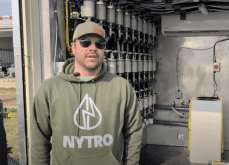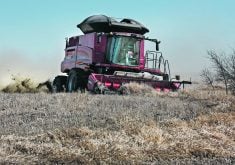PARKBEG, Sask. – A few years ago during harvest, Phil Simrose hit a hole and broke the rear axle on his Case IH 1688 combine.
“The whole back of the combine went down, which isn’t nice,” said Simrose, who farms near Parkbeg. “It was not a fun thing.”
After fixing the axle, he decided to add more steel so it wouldn’t break again.
“I beefed up the back axle. That’s one weak point on the combine. I don’t know if it’s that we run over too rough country or what. But I know the wreckers say it will break (on that combine),” he said.
Read Also

VIDEO: Ag in Motion documentary launches second season
The second season of the the Western Producer’s documentary series about Ag in Motion launched Oct. 8.
“It breaks right at the pivot point of the walking beam. I could have got another one, but then I’m back where I was to start. So I put some extra steel in there. You probably wouldn’t need as much as I put in, but that was just the steel I had around at the time.”
Simrose welded a piece of flat iron across the bottom of the axle and square tubing across the top.
“You could probably just put flat iron on the top, too, but that was the steel I had around. After falling down like it did, I wanted to give it a little more.”
When Simrose first bought the combine, the rear axle was extended quite wide. He narrowed the axle to reduce both stress and the chance that it would break again.
“I didn’t think I needed it that wide. I slid them in after the first one broke. Then you’ve got a lot less bending on it.”
While Simrose’s combine is a model 1688, he said the machines are similar from the 1480 to the 2388.
“It’s something you might want to do if your combine is getting up in age. I did it after the fact, but maybe a person might want to do it before.”
Simrose said the rails on his Case IH 1688 combine are built fairly light where the chaffer sits and eventually they crack and break.
“I talked to the combine wreckers when (mine) broke, because it’s about $600 a rail to replace it. They said they don’t have any that are any good. They either come in cracked or if there’s one that’s any good, it’s gone the next day. So obviously it’s a weak point, and they’ve been making them that way since the 1480s,” Simrose said.
“There’s not a whole lot of steel in them, especially around where the front bolt attaches to it. That’s where it busted out. It cracked up a bit around the back one too, but it’s at the front where they’ll break.”
While they may be a bit thin for his liking, Simrose said there’s a lot of room where extra flat iron can be welded to reinforce it around the bolt holes. To make the reinforcement, he took the chaffer out and removed the rails from the combine.
“I punched out a hole in the flat iron where the bolt goes, then set the flat iron right over it and reinforced it that way. On the back, too, I put a little bit extra. The front is the main part, where the pin goes through. There’s lots of room to reinforce it around the pin, with a little extra steel welded on, and you’ll be better off.”
He said many rails on older combines are cracked around the front pin.
“(Fixing that) can save you a lot of trouble. I’d reinforce it right away. If it breaks in the field, you’re liable to bust up your chaffer. When it broke in the field, it broke up my chaffer and I had to weld that up. (This reinforcement) would save you a lot of trouble.”














